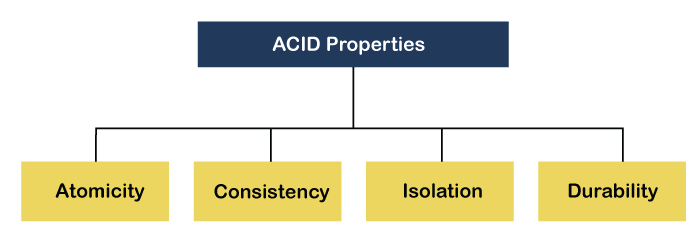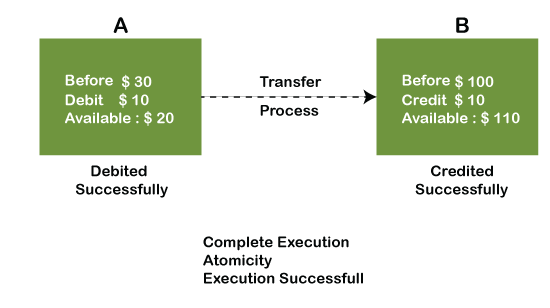ACID Properties in DBMS: Ensuring Data Integrity and Reliability
The term ACID Properties in DBMS is the very first component in this article about the importance of the term in the database management system (DBMS). The ACID Properties in DBMS, which stands for Atomicity, Consistency, Isolation, and Durability, is the key to DBMS principles. These ACID properties in DBMS are the means by which any DBMS transaction must be treated in order to make it function as it should, even when the system has faults or errors, or when power is down.
Being thoroughly familiar with and carrying out the ACID Properties in DBMS is the responsibility of all software developers, database administrators, and all other parties participating in database operations. These ACID Properties in DBMS are the foundational pillars of database reliability and are highly supportive of databases’ ability to continue to keep their integrity in place. Inadequate ACID Properties in DBMS, on the other hand, may be the reason for data to be incorrect, to exist in several variants, or to be deleted unexpectedly, which causes developers’ and business stakeholders’ application performance and users severe problems.
ACID Properties constitutes a vital part of the DBMS, in fact that they make sure that every transaction is processed in a way that respects the correctness and consistency of the data. ACID Properties are observed in a database management system (DBMS) by developers in prior to specifying the conditions under which the system will function and its resilience to failure. Consequently, accounting for and applying the ACID Properties in DBMS is indispensable in the construction of dependable, flexible, and safe database systems that might face the expected and the unexpected issues.

Atomicity: The “All or Nothing” Principle
- Atomicity is said to be the property that means a database transaction is a single integrated piece of work. This means that it cannot be divided. A transaction is either done completely, or it is not done at all.
- The term “atomic” comes from the presentment of an atomic operation, which is the one that can’t be broken apart.
- In other words, atomicity makes sure that all operations within a single transaction are executed correctly, or none of them is executed at all.
Key Points of Atomicity:
- All Operations Must Succeed: If a transaction contains multiple steps, and one of them fails, the whole transaction is canceled, and no database changes are made.
- Transaction Rollback: If an error or failure happens during a transaction, the database will have the ability to roll back and make it seem as though no transaction took place.
Example of Atomicity:
In the case of an online banking system in which Alice sends $500 to Bob, the following transaction may occur:
- Debit $500 from Alice’s account.
- Credit $500 to Bob’s account.
For instance, suppose the system successfully debits Alice’s account but fails while crediting Bob’s account (say, due to a system crash). In this case, the amount of money is subtracted from Alice’s account while Bob’s account is not credited. This discrepancy is because of the problem. In order to secure atomicity, after the amount got deducted from Alice’s account, the whole transaction should be canceled, and Alice’s account should be returned back to its original state thereby the money should stay in her account as if there was no transfer.

Consistency: Ensuring Database Integrity
- The main transaction that the database undergoes is changing the database from one correct state to the other by assuring that all the system’s integrity conditions are satisfied.
- The fact that the database is never moved from a consistent state to an inconsistent one, a transaction by transaction basis, thus always containing accurate data being based on the rules set by the database schema.
- Consistency as related to DBMS involves standards such as primary keys, foreign keys, and data types, and sets of additional constraints like CHECK constraints and triggers.
Key Points of Consistency:
- Data Integrity: From the situation before the transaction and after the transaction, the database must satisfy the integrity constraints. The transaction must not cause the rules to be violated or make data inconsistent.
- Enforcing Business Rules: Consistency guarantees that the business logic statements that are reflected in the database schema (for instance, one cannot go below zero in a bank balance) are enforced and data is in a valid state after each transaction.
Example of Consistency:
Consider a student table in a database that has a student_id and age. You might have a requirement that the age of students should be between 18 and 100. Therefore, a transaction that updates the age to a value out of that range would cause the integrity constraints to break and the consistency of the database to be violated.
Suppose the following transaction occurs:
- The student’s age is updated to 15 which disobeys the rule of the age of students being at least 18 (students should be at least 18).
- The DBMS will stop updating it to avoid inconsistency in data and to keep it consistent.
Isolation: Ensuring Transactions Do Not Interfere with Each Other
- Isolation is the property that makes sure the concurrent transaction doesn’t conflict with each other.
- A database executes multiple transactions at the same time; hence, it should be able to process them in a manner that the results of every transaction are independent of the other or others.
- Namely, situations that the transactions involve tables or rows all transactional transactions that include the same reshared resources.
- It is possible that the level of isolation between the transactions is not the same due to the isolation level defined in the database.
- Generally, the SQL standard defines the given isolation levels which escalate from the smallest to the most restrictive:
- Read Uncommitted: Transactions are authorized to read information that is under the process of being modified by other transactions, and so it is possible for instances to read dirty data (data that may be rolled back).
- Read Committed: Transactions are allowed to read only those records that have been committed (finalized), but other transactions may interfere with the data being read.
- Repeatable Read: No other transaction can modify that particular value if a transaction has read the value once (the transaction is executed).
- Serializable: This isolation level allows transactions to be executed in a serial order, where no two transactions interfere with each other.
Key Points of Isolation:
- Concurrency Control: Isolation ensures that all transaction are provided with the full process without compromising on the correctness of the implementation.
- Locking Mechanisms: DBMS operating systems are using different types of locks (read lock, write lock, etc.) to hurdles data isolation and make sure that one transaction is not contradicting information used by another.
Example of Isolation:
If you imagine two users, Alice and Bob, who are withdrawing money from the same bank account simultaneously, what is the scenario that will be likely to happen without proper isolation? Alice, maybe, would get a balance of $1000 and thus desires to get out $500 while Bob also gets a balance that is still $1000 and then tries to do a withdrawal of $700.
- Alice checks the balance and it shows one thousand dollars as she thinks of withdrawing half of the money, $500.
- Bob also verifies the balance, and it still shows $1000, and he does the withdraw by taking $700 from the account.
- Not so long ago, the inability of Bob and Alice to reconcile would result in negative account balances, which do not comply with standards.
As an example, this is a correct isolation mechanism where the transactions are handled such that Alice would have to wait for Bob to finish, or vice versa, until one of them completes the other transaction. By doing this, the system will prevent any two transactions from operating on the same data simultaneously.
Durability: Ensuring Data Persistence
- Durability is removed from the imagination that in an event of a system fault of any sort like a power outage, crash or hardware failure, the database changes resulting from a transaction are made permanently and nothing can be deleted or lost.
- This relational property ensures that the system will always maintain the stability of the data and that it can recover any crash through transaction logs preserving everything.
Key Points of Durability:
- Permanent Data: Once a transaction is committed it cannot be lost. If a crash occurs, the system will be able to recover the committed transaction.
- Transaction Logs: A transaction log is a file that stores information on all transactions in a database management system. These transaction logs are used for recovery purposes during system faults or if a wrong transaction is committed. To recover data, the crashed system repair must use the transaction logs properly.
Example of Durability:
Think of a case where a customer makes a purchase order through the internet. The transaction will include:
- Decreasing the inventory count due to the stock sold.
- the financial transaction (using the credit card).
Subsequent to the transaction the system should update the inventory count and a customer’s payment should be carried out smoothly. If a crash happens immediately after the transaction, the inventory count should still exist and the customer’s payment information should still be there.
ACID in Action: A Full Example
Let’s have a practical example illustrate how the four ACID properties work together
Reading a very simple e-commerce platform where a customer is purchasing a product will make the following to in your mind
- Check the product availability status
- Withdraw the amount from the customer’s account for the payment
- Make an entry on the inventor
Atomicity:
- Whether it is a situation where the inventory update fails after the payment is processed, or it is any other problem, the whole transaction will be canceled.
- In other words, the payment will be reveres and the transaction will not be updated. This way, the transaction will be atomic, meaning it will either be successful or it will fail totally, the way it is supposed to be.
Consistency:
- The main thing that each transaction communicates with the database, and it must be in the same predictable state before and after the transaction.
- For instance, the client’s account must be updated with the correct stock count, and the product stock must be replenished to the same level.
- The database will enforce the above rule and make sure that the sales transaction will be the only action taken in the lift.
Isolation:
- Should Alice buy a product while Bob is also trying to buy the same product simultaneously, the database will make sure no conflicts occur, and only one of the users will be able to complete the transaction.
- For example, if Alice purchases a product and Bob wants to buy the same product at the same time, in an isolated transaction, one of the transactions is processed first ensuring the stability of the changes onto the data store
Durability:
- When the transaction is saved to the database after it is successfully committed, the need for the changes (payment, inventory update) is forever gone and eventually, if a system crash occurs, it won’t be lost because the transaction is already there and safe in the database.
